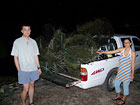

 | |||||||||||||
|
|
Journals 2007/2008Beth Jewell
January 19, 2008 I woke up this morning before sunrise and decided to go out on the deck to try my luck at a sunrise photo. Sunrise and sunset photos are not easy to get, as there always seems to be a bank of clouds on the horizon. At one point during the night I could feel us steaming so I knew I would be waking up to new surroundings. I headed for the bow with a cup of coffee in hand and was pleasantly surprised when I heard sea lion bulls bellowing up and down the coastline along with the females and pups calling to one another. Wad anchored just offshore of a sea lion colony. As the sun began to rise and illuminate the coastline I watched 2 males clash with one another, sending the looser swimming in the water in defeat.
The last major passage between dives sites on this cruise was much like all of the others. The researchers double-checked their cameras and gear, logged in data from the previous dives, and took naps. The crew cleaned the boat, filled dive tanks, and prepared the next meal. I sat on the bow, basking in the sun; in hopes of watching the manta rays leap from the water. I was not disappointed as I saw more on this passage than any of the previous ones. A shark swam just off the portside with his dorsal fin above the water line. We surprised several floating sea lions and turtles along the way as well. The frequency of birds increases as we approach the shoreline. In the morning and late afternoon we see lava gulls, blue-footed boobies, and cormorants dive into the water searching for their next meal. During the midpart of the day, most of the birds are tucked into the rock ledges.
We arrived back into port around 6:30. It took several trips with the panga to unload dive and personal gear. Three taxis were required to get all of us and the gear back to the Charles Darwin Research Station. The sea urchin cages took up so much room in the bed of the trucks. After unloading and showers, we were off to town to find dinner around 8. Everyone was worn out.
Jon Witman's Dive Notes: |
||||||||||||


